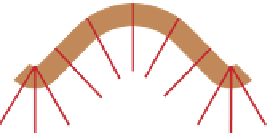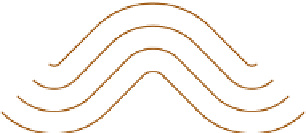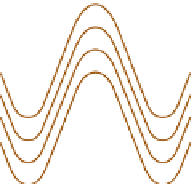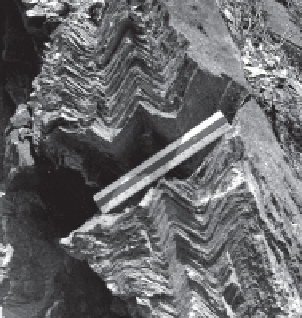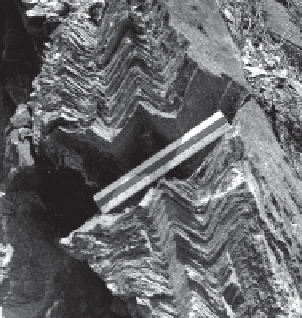Geoscience Reference
In-Depth Information
8.3.4 Magnitude of shear strain
Assessing how much strain a rock has undergone is seldom
easy. In rare cases a deformed object can be compared with its
known shape and size before deformation (e.g. a fossil). High-
strain rocks tend to show strong parallelism of planar and
linear ductile elements, while aspect ratios of more rigid
objects increase at higher strains. Roughly spherical objects
(e.g. ooids, pebbles, reduction spots) will deform into ellipsoids
(Figure 8.21), with a ratio of long to short axes that can yield
an estimate of the strain magnitude.
Folds are best observed (and
sketched) in the profi le plane,
i.e. at 90° to the fold axis, if
possible. This section through
a fold represents its key
characteristics (symmetry,
shape, etc.) most faithfully.
8
8.3.5 Fold analysis
Many rocks contain planar surfaces that bend during
deformation, forming folds of diverse shapes. Describing and
sketching fold types can yield useful information on their host
rock and the conditions under which they formed (temperature,
depth, strain intensity). The general anatomy of a fold is
illustrated in Figure A8.2 (Appendix 8).
Size, shape and orientation should be considered in describing
folds. Fold sizes can be summarized by recording their
amplitudes and wavelengths (e.g. on a sketch). Folds occur at
all scales, and minor folds superimposed on a larger fold occur
commonly during a single deformation event. Fold shape is
very variable, and can be described in a number of ways. You
should note the direction of fold closure (antiform or
synform?), and the interlimb angle (Figure A8.3), which gives a
clue to the amount of strain the folded rocks have experienced.
Open folds refl ect relatively low strains, whereas isoclinal folds
indicate high strain intensities typical of shear zones at depth
in orogenic belts (Figure 8.22). The shape of the folded layer in
the profi le plane is also important; are the folds in a series of
neatly stacked chevrons (Figure 8.23a), or are they disharmonic
(Figure 8.23b)? Are successive layers parallel, or similar in
shape (Figure 8.23c and d)? Fold shape refl ects the relative
competence of the layers at the time of fold formation.
(a)
(b)
In complex deformed zones such as orogenic belts, way-up
evidence becomes important. Strata, and even whole structures,
may be inverted. The younging direction of way-up features
(e.g. erosion structures, graded bedding), determined parallel to
(c)
Figure 8.23
Examples of different fold shapes. (a) Chevron folds,
common in uniformly layered strata at relatively shallow crustal levels,
Tennessee, USA. (b) Disharmonic folds refl ect contrasting rheologies of
different layers. (c) Parallel folds imply competent layers. (d) Similar folds,
with thickened hinge areas and thinned limbs, suggest weaker rocks that
can deform easily. (a: Courtesy of the U.S. Geological Survey; Photographer
W. B. Hamilton. b: Tom W. Argles, The Open University, UK.)
(d)




